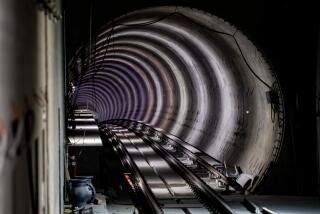PERSPECTIVES ON THE MTA : It’s Not Either/Or; We Need Rail <i> and </i> Bus : Critics of the Pasadena Blue Line are wrong to make it a poor versus rich, minority versus non-minority issue.
Having failed to kill the Los Angeles-to-Pasadena Blue Line project during budget deliberations of the Metropolitan Transportation Authority, opponents of the project have gone to federal court to paralyze the ongoing construction of a system that twice was approved by the voters.
When they adopted Propositions A and C in 1980 and 1990, respectively, the people of Los Angeles County issued an unmistakable mandate by choosing rail as part of the region’s transportation future.
No one, of course, can support the MTA’s fiscal and operational mismanagement that has led to serious budget shortfalls. Nor should the MTA budget and its inefficiencies be balanced on the backs of those least able to afford it.
It is also important to differentiate between the Blue Line light rail, whose construction has been virtually problem-free, from the Metro Red Line heavy-rail subway train, which has been marred by construction-related problems.
But opponents have skillfully and cynically twisted MTA problems, half-truths and inaccurate information to create phony dilemmas of bus versus rail and affluent versus poor. More than 63% of those living along the Pasadena Blue Line corridor are minorities, including lower-income Latinos and African Americans, who constitute the vast majority of transit users. But all residents, regardless of ethnic makeup, will enjoy the benefits that come from the expanded transit opportunities.
Opponents also completely ignore the economic implications of the Blue Line and overall light-rail program for Southern California. Today, traffic congestion and air pollution are a way of life. Without public transportation improvements, the average speed of rush-hour traffic will grind to 17 m.p.h. Wasted employee time and bottle-necked flow of goods and services will mean potential business losses of $2 billion annually.
Rail lines would vastly reduce the region’s smog problems and the regulatory burden placed on the economy. They would also attract future housing and businesses along rapid transit corridors.
The region needs more transportation. But we can no longer build ourselves out of our transportation quandary with more freeways. And buses alone cannot meet the complex demands.
A small group thinking only of its needs today has chosen to throw legal roadblocks in the path of Southern California’s transportation future.
The issue is not about choosing bus over rail transit. It’s about the clear mandate the people expressed when they voted for Propositions A and C.
More to Read
Sign up for Essential California
The most important California stories and recommendations in your inbox every morning.
You may occasionally receive promotional content from the Los Angeles Times.










